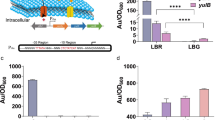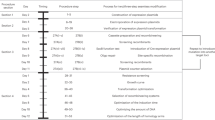Abstract
Bacillus subtilis and its closely related species are important strains for industry, agriculture, and medicine. However, it is difficult to perform genetic manipulations using the endogenous recombination machinery. In many bacteria, phage recombineering systems have been employed to improve recombineering frequencies. To date, an efficient phage recombineering system for B. subtilis has not been reported. Here, we, for the first time, identified that GP35 from the native phage SPP1 exhibited a high recombination activity in B. subtilis. On this basis, we developed a high-efficiency GP35-meditated recombineering system. Taking single-stranded DNA (ssDNA) as a recombineering substrate, ten recombinases from diverse sources were investigated in B. subtilis W168. GP35 showed the highest recombineering frequency (1.71 ± 0.15 × 10−1). Besides targeting the purine nucleoside phosphorylase gene (deoD), we also demonstrated the utility of GP35 and Beta from Escherichia coli lambda phage by deleting the alpha-amylase gene (amyE) and uracil phosphoribosyltransferase gene (upp). In all three genetic loci, GP35 exhibited a higher frequency than Beta. Moreover, a phylogenetic tree comparing the kinship of different recombinase hosts with B. subtilis was constructed, and the relationship between the recombineering frequency and the kinship of the host was further analyzed. The results suggested that closer kinship to B. subtilis resulted in higher frequency in B. subtilis. In conclusion, the recombinase from native phage or prophage can significantly promote the genetic recombineering frequency in its host, providing an effective genetic tool for constructing genetically engineered strains and investigating bacterial physiology.






Similar content being viewed by others
References
Anagnostopoulos C, Spizizen J (1961) Requirements for transformation in Bacillus subtilis. J Bacteriol 81(5):741–746
Ayora S, Missich R, Mesa P, Lurz R, Yang SX, Egelman EH, Alonso JC (2002) Homologous-pairing activity of the Bacillus subtilis bacteriophage SPP1 replication protein G35P. J Biol Chem 277(39):35969–35979. doi:10.1074/jbc.M204467200
Bashkirov VI, Khasanov FK, Prozorov AA (1987) Illegitimate recombination in Bacillus subtilis nucleotide sequences at recombinant DNA junctions. Mol Gen Genet 210(3):578–580. doi:10.1007/Bf00327215
Brigidi P, De Rossi E, Bertarini ML, Riccardi G, Matteuzzi D (1990) Genetic transformation of intact cells of Bacillus subtilis by electroporation. FEMS Microbiol Lett 55(1–2):135–138
Court DL, Sawitzke JA, Thomason LC (2002) Genetic engineering using homologous recombination. Annu Rev Genet 36:361–388. doi:10.1146/annurev.genet.36.061102.093104
Datta S, Costantino N, Court DL (2006) A set of recombineering plasmids for gram-negative bacteria. Gene 379:109–115. doi:10.1016/j.gene.2006.04.018
Datta S, Costantino N, Zhou XM, Court DL (2008) Identification and analysis of recombineering functions from Gram-negative and Gram-positive bacteria and their phages. Proc Natl Acad Sci U S A 105(5):1626–1631. doi:10.1073/pnas.0709089105
Deans TL, Cantor CR, Collins JJ (2007) A tunable genetic switch based on RNAi and repressor proteins for regulating gene expression in mammalian cells. Cell 130(2):363–372. doi:10.1016/j.cell.2007.05.045
Deng AH, Wu J, Zhang Y, Zhang GQ, Wen TY (2010) Purification and characterization of a surfactant-stable high-alkaline protease from Bacillus sp B001. Bioresour Technol 101(18):7100–7106. doi:10.1016/j.biortech.2010.03.130
Duitman EH, Hamoen LW, Rembold M, Venema G, Seitz H, Saenger W, Bernhard F, Reinhardt R, Schmidt M, Ullrich C, Stein T, Leenders F, Vater J (1999) The mycosubtilin synthetase of Bacillus subtilis ATCC6633: a multifunctional hybrid between a peptide synthetase, an amino transferase, and a fatty acid synthase. Proc Natl Acad Sci U S A 96(23):13294–13299. doi:10.1073/pnas.96.23.13294
Ellis HM, Yu DG, DiTizio T, Court DL (2001) High efficiency mutagenesis, repair, and engineering of chromosomal DNA using single-stranded oligonucleotides. Proc Natl Acad Sci U S A 98(12):6742–6746. doi:10.1073/pnas.121164898
Fabret C, Ehrlich SD, Noirot P (2002) A new mutation delivery system for genome-scale approaches in Bacillus subtilis. Mol Microbiol 46(1):25–36. doi:10.1046/j.1365-2958.2002.03140.x
Gietz RD, Woods RA (2002) Transformation of yeast by lithium acetate/single-stranded carrier DNA/polyethylene glycol method. Methods Enzymol 350:87–96
Haijema BJ, Venema G, Kooistra J (1996) The C terminus of the AddA subunit of the Bacillus subtilis ATP-dependent DNase is required for the ATP-dependent exonuclease activity but not for the helicase activity. J Bacteriol 178(17):5086–5091
Hofemeister J, Israelireches M, Dubnau D (1983) Integration of plasmid-pE194 at multiple sites on the Bacillus subtilis chromosome. Mol Gen Genet 189(1):58–68. doi:10.1007/Bf00326055
Jiang WY, Bikard D, Cox D, Zhang F, Marraffini LA (2013) RNA-guided editing of bacterial genomes using CRISPR-Cas systems. Nat Biotechnol 31(3):233–239. doi:10.1038/Nbt.2508
Kooistra J, Haijema BJ, Venema G (1993) The Bacillus subtilis addAB genes are fully functional in Escherichia coli. Mol Microbiol 7(6):915–923. doi:10.1111/j.1365-2958.1993.tb01182.x
Li XT, Costantino N, Lu LY, Liu DP, Watt RM, Cheah KSE, Court DL, Huang JD (2003) Identification of factors influencing strand bias in oligonucleotide-mediated recombination in Escherichia coli. Nucleic Acids Res 31(22):6674–6687. doi:10.1093/nar/gkg844
Maresca M, Erler A, Fu J, Friedrich A, Zhang YM, Stewart AF (2010) Single-stranded heteroduplex intermediates in lambda Red homologous recombination. BMC Mol Biol 11(54):54. doi:10.1186/1471-2199-11-54
Mosberg JA, Lajoie MJ, Church GM (2010) Lambda red recombineering in Escherichia coli occurs through a fully single-stranded intermediate. Genetics 186(3):791–799. doi:10.1534/genetics.110.120782
Muyers JPP, Zhang YM, Testa G, Stewart AF (1999) Rapid modification of bacterial artificial chromosome by ET-recombination. Nucleic Acids Res 27(6):1555–1557. doi:10.1093/nar/27.6.1555
Nijland R, Burgess JG, Errington J, Veening JW (2010) Transformation of environmental Bacillus subtilis isolates by transiently inducing genetic competence. PLoS ONE 5(3):e9724. doi:10.1371/journal.pone.0009724
Ranallo RT, Barnoy S, Thakkar S, Urick T, Venkatesan MM (2006) Developing live Shigella vaccines using lambda red recombineering. FEMS Immunol Med Microbiol 47(3):462–469. doi:10.1111/j.1574-695X.2006.00118.x
Robzyk K, Kassir Y (1992) A simple and highly efficient procedure for rescuing autonomous plasmids from yeast. Nucleic Acids Res 20(14):3790
Sambrook J, Fritsch EF, Maniatis T (1989) Molecular cloning: a laboratory manual, 2nd ed. Cold Spring Harbor Laboratory Press, Cold Spring Harbor, pp 53–84
Schenk S, Laddaga RA (1992) Improved method for electroporation of Staphylococcus aureus. FEMS Microbiol Lett 73(1–2):133–138
Schmittgen TD, Livak KJ (2008) Analyzing real-time PCR data by the comparative C-T method. Nat Protoc 3(6):1101–1108. doi:10.1038/nprot.2008.73
Shao Z, Zhao H, Zhao H (2009) DNA assembler, an in vivo genetic method for rapid construction of biochemical pathways. Nucleic Acids Res 37(2):e16. doi:10.1093/nar/gkn991
Sharan SK, Thomason LC, Kuznetsov SG, Court DL (2009) Recombineering: a homologous recombination-based method of genetic engineering. Nat Protoc 4(2):206–223. doi:10.1038/nprot.2008.227
Stephenson M, Jarrett P (1991) Transformation of Bacillus subtilis by electroporation. Biotechnol Tech 5(1):9–12. doi:10.1007/Bf00152746
Tamura K, Peterson D, Peterson N, Stecher G, Nei M, Kumar S (2011) MEGA5: molecular evolutionary genetics analysis using maximum likelihood, evolutionary distance, and maximum parsimony methods. Mol Biol Evol 28(10):2731–2739. doi:10.1093/molbev/msr121
Tang X, Morris SL, Langone JJ, Bockstahler LE (2006) Simple and effective method for generating single-stranded DNA targets and probes. Biotechniques 40(6):759–763. doi:10.2144/000112154
van Kessel JC, Hatfull GF (2007) Recombineering in Mycobacterium tuberculosis. Nat Methods 4(2):147–152. doi:10.1038/nmeth996
van Kessel JC, Hatfull GF (2008) Efficient point mutagenesis in mycobacteria using single-stranded DNA recombineering: characterization of antimycobacterial drug targets. Mol Microbiol 67(5):1094–1107. doi:10.1111/j.1365-2958.2008.06109.x
van Kessel JC, Marinelli LJ, Hatfull GF (2008) Recombineering mycobacteria and their phages. Nat Rev Microbiol 6(11):851–857. doi:10.1038/Nrmicro2014
van Pijkeren JP, Britton RA (2012) High efficiency recombineering in lactic acid bacteria. Nucleic Acids Res 40(10):e76. doi:10.1093/nar/gks147
Wang PZ, Doi RH (1984) Overlapping promoters transcribed by Bacillus subtilis sigma-55 and sigma-37 RNA-polymerase holoenzymes during growth and stationary phases. J Biol Chem 259(13):8619–8625
Wang JJ, Rojanatavorn K, Shih JCH (2004) Increased production of Bacillus keratinase by chromosomal integration of multiple copies of the kerA gene. Biotechnol Bioeng 87(4):459–464. doi:10.1002/Bit.20145
Wang Y, Weng J, Waseem R, Yin XH, Zhang RF, Shen QR (2012) Bacillus subtilis genome editing using ssDNA with short homology regions. Nucleic Acids Res 40(12):e91. doi:10.1093/nar/gks248
Wen S, Yang JG, Tan TW (2013) Full-length single-stranded PCR product mediated chromosomal integration in intact Bacillus subtilis. J Microbiol Methods 92(3):273–277. doi:10.1016/j.mimet.2012.11.012
Xue GP, Johnson JS, Dalrymple BP (1999) High osmolarity improves the electro-transformation efficiency of the gram-positive bacteria Bacillus subtilis and Bacillus licheniformis. J Microbiol Methods 34(3):183–191. doi:10.1016/S0167-7012(98)00087-6
Yan X, Yu HJ, Hong Q, Li SP (2008) Cre/lox system and PCR-based genome engineering in Bacillus subtilis. Appl Environ Microbiol 74(17):5556–5562. doi:10.1128/Aem. 01156-08
Zhang YM, Buchholz F, Muyrers JPP, Stewart AF (1998) A new logic for DNA engineering using recombination in Escherichia coli. Nat Genet 20(2):123–128. doi:10.1038/2417
Zhang GQ, Bao P, Zhang Y, Deng AH, Chen N, Wen TY (2011) Enhancing electro-transformation competency of recalcitrant Bacillus amyloliquefaciens by combining cell-wall weakening and cell-membrane fluidity disturbing. Anal Biochem 409(1):130–137. doi:10.1016/J.Ab.2010.10.013
Zhang GQ, Wang WZ, Deng AH, Sun ZP, Zhang Y, Liang Y, Che YS, Wen TY (2012) A mimicking-of-DNA-methylation-patterns pipeline for overcoming the restriction barrier of bacteria. PLoS Genet 8(9):e1002987. doi:10.1371/journal.pgen.1002987
Acknowledgments
This work was supported by grants from the National Natural Science Foundation of China (31170103) and the Chinese Academy of Sciences (KSCX2-EW-J-6). We thank Prof. Donald L. Court (National Cancer Institute at Frederick) for kindly providing the chromosomes of strains SIMD40-43 and SIMD44-50 for cloning recombinases and Dr. Mingchun Li for S. cerevisiae DAY414 and BGSC for various shuttle plasmids. We are grateful to Tong Zhao for the flow cytometry analysis.
Author information
Authors and Affiliations
Corresponding author
Electronic supplementary material
Below is the link to the electronic supplementary material.
ESM 1
(PDF 2411 kb)
Rights and permissions
About this article
Cite this article
Sun, Z., Deng, A., Hu, T. et al. A high-efficiency recombineering system with PCR-based ssDNA in Bacillus subtilis mediated by the native phage recombinase GP35. Appl Microbiol Biotechnol 99, 5151–5162 (2015). https://doi.org/10.1007/s00253-015-6485-5
Received:
Revised:
Accepted:
Published:
Issue Date:
DOI: https://doi.org/10.1007/s00253-015-6485-5




